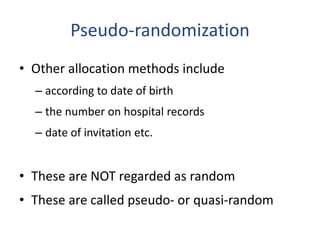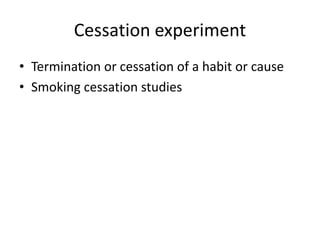8. randomized control trials
- 1. Randomized Controlled Trial Maj Dr Naveen Phuyal MBBS, MD
- 2. Randomized Control Trial Maj Dr Naveen Phuyal MBBS, MD
- 5. Consider how you would go about evaluating the following interventions – Surgical versus medical termination of pregnancy – Referral guidelines for radiographic examination – Paracetamol and/or ibuprofen for treating children with fever – Nurse counsellors as an alternative to clinical geneticists for genetic counselling – Single dose of chemotherapy versus radiotherapy treating testicular cancer Cervical cancer vaccine
- 6. The need to evaluate health care • Variations in health care • Unproven treatments • Inadequacies in care • Inaccurate medical models • Limitation of resources • New innovations • … Crombie (1996)
- 7. Simple Definition • A study in which people are allocated at random to receive one of several interventions (simple but powerful research tool)
- 8. Trial participants CONTROLEXPERIMENT RANDOMLY allocated to experimental or CONTROL group
- 9. • Random allocation to intervention groups • All participants have equal chance of being allocated to each intervention group why RCTs are referred to as randomised controlled trials
- 10. • One intervention is regarded as control treatment (the group of participants who receive this are the control group) • NOTE: Contemporaneous (not historical controls) why RCTs are referred to as randomised controlled trials
- 11. Experimental Group • receive new intervention • (also called treatment group or intervention group interchangeably) Control Group • can be – conventional practice – no intervention (this may be conventional practice) – placebo
- 12. • RCTs are – Experiments: investigators can influence number, type, regime of interventions – Quantitative: measure events rather than try to interpret them in their natural settings – Comparative: compare two or more interventions
- 13. Inclusion/exclusion criteria • Decision rules applied to potential trial participants to judge eligibility for inclusion in trial • See CONSORT statement www.consort-statement.org • Important that they are applied identically to all groups in a trial!
- 14. Randomization • Randomisation is the process of random allocation • Allocation is not determined by investigators, clinicians or participants • Equal chance of being assigned to each intervention group • Individual people – patients – caregivers (physicians, nurses etc) • Groups of people, ‘cluster randomisation’
- 15. Pseudo-randomization • Other allocation methods include – according to date of birth – the number on hospital records – date of invitation etc. • These are NOT regarded as random • These are called pseudo- or quasi-random
- 16. • Controlled clinical trials (CCTs) are not the same as randomised controlled trials • Controlled clinical trials include non- randomised controlled trials and randomised controlled trials
- 17. Why randomization? • Characteristics similar across groups at baseline • Can isolate and quantify impact of interventions with effects from other factors minimised • Risk of imbalance not abolished completely even if perfect randomisation • To combat selection bias
- 18. Why do we need a control group? • Don’t need a control group if completely predictable results – Parachutes when jumping from plane – New drug cures a few rabies cases • But – No intervention has 100% efficacy – Many diseases recover spontaneously
- 19. Classification of Randomised Trials • Parallel Group – Randomly assigned to 2 groups – Treatment vs non treatment • Crossover – Over time random sequence of intervention • Split Body – eg Right vs Left Random treatment vs No Treatment • Cluster – Pre-existing Groups eg Villages/Schools • Factorial – Combination of interventions / non interventions in Random groups
- 20. Classification of Randomised Trials By outcome of interest (efficacy vs. effectiveness) • RCTs - "explanatory" – Test efficacy – Highly selected participants – Highly Controlled conditions • RCTs – “pragmatic.” – Test effectiveness in every day practice – Unselected Participants – Flexible Conditions – Give informed decisions about practice
- 21. Classification of Randomised Trials By hypothesis (superiority vs. noninferiority vs. equivalence) • "superiority trials" (most) – statistically significant • "noninferiority trials” – new treatment no worse than existing Rx • "equivalence trials" - x2 Rx indistiguishable
- 22. Classification of Randomised Trials • By blinding • Open trials • Single blind trials • Double blind trails • Triple blind trials
- 24. Randomisation - Goals • Equal Group Sizes for Adequate Statistical Power (Especially Subgroup Analyses) • Low selection bias (investigator cannot predict the next subject's group assignment by examining which group has been assigned the fewest subjects up to that point) • Low probability of confounding (i.e., a low probability of "accidental bias"),
- 25. Methods of carrying out randomization • Coin tossing • Random number table • Computer based randomization • Sealed envelopes • Telephone randomization • Pharmacy randomization • Web based randomization • Attendance sheets
- 26. Six essential steps • Drawing up a protocol • Selecting reference and experimental populations • Randomization • Manipulation or intervention • Follow up • Assessment of outcome
- 27. Drawing up a protocol • Aims and objectives of the study • Questions to be answered • Sample size • Criteria and procedure for selection of both groups • Procedure for allocation in both groups • Treatments to be applied • Responsibilities of parties • Once a protocol ahs been made its should be strictly adhered • Prevents bias and errors • Pilot studies’ – Feasibility, acceptability, operational efficiency
- 28. Selecting reference and experimental population Reference (Target)population • Populations to which the findings may be applicable • As broad as mankind or Limited to geographical area, age, sex, occupation, social groups • Whole city, school children, industrial workers, obstetric population Experimental population • Derived from reference population • Actual population that participates in study • Ideally randomly chosen • Choose a stable population • 3 criteria's – Informed consent – Representative – Eligible
- 29. Randomization • Definition • Attempt to eliminate bias and allow comparability- not matching • Like can be compared to like • No selection bias • Best done using random number tables
- 30. Manipulation • Intervene or manipulate the study • Delibrate application or withdrawal • Reduction of a suspected factor • Independent variable ( drug, vaccine, habit) and dependent variable ( incidence of disease, survival time, recovery period)
- 31. Follow up • At definite intervals of time • In a standard measure • Equal intensity • Same given circumstances • Duration of trial= outcome(start- end) • Losses to follow up(attrition): death, migration, loss of interest
- 32. Assessment • Positive results – Reduced incidence of disease – Reduced cost to HCS • Negative results – Side effects – Complications – Death • Bias may arise at three sources – Participants : Subject variation – Observer bias – Bias in evaluation – Randomization cannot guard against this bias so a technique called blinding is used.
- 33. Blinding • Single blind trial • Double blind trial • Triple blind trial
- 34. Types of Randomized controlled trials • Clinical trail • Preventive trial • Risk factor trial • Cessation experiments • Trial of etiological agents • Evaluation of health services
- 35. Clinical trial • Evaluation of beta-blockers in decreasing CVD mortality • Trails of folate supplementation before conception to prevent NTD. • Trials of Aspirin in CVD mortality • RCT of coronary bypass surgery in MI.
- 36. Preventive trials • Handwashing • Vaccines • Whopping cough vaccination trial
- 37. Risk factor trials • Study of risk factors • Major risk factor for CAD is elevated cholesterol, smoking, HTN, sedentary lifestyle. • So reducing cholesterol, quitting smoking, control of BP and regualr physical exercise prevents CAD. • The Stanford Three community trial • North Karelia Project • MRFIT trial
- 38. Cessation experiment • Termination or cessation of a habit or cause • Smoking cessation studies
- 39. Trial of etiological agents • Retrolental fibroplagia as a cause of blindness
- 40. Evaluation of Health services • Effectiveness and efficiency of health services • Domicillary treatement vs sanitoriaum treatment of TB
- 41. Non-randomized trials • Uncontrolled trials (trials with no comparison groups). Eg. Pap smear test reduces mortality from Cx CA • Natural experiments: cigerrete smokig: smokers vs non smokers • Before and after comparison studies • (eg. James Lind and scurvy) – Using a control group – Without a control group
- 43. Thank You
Editor's Notes
- #30: Randomization is a statistical procedure by which participants are allocated into groups called “study” and “control” groups, to receive or not to receive AN EXPERIMENTAL PREVENTIVE OR THERAPEUTIC PROCEDURE, MANOEVRE, OR INTERN=VENTION.











































